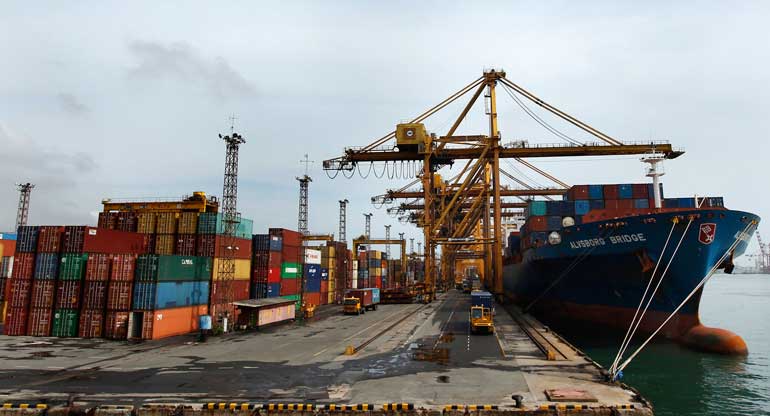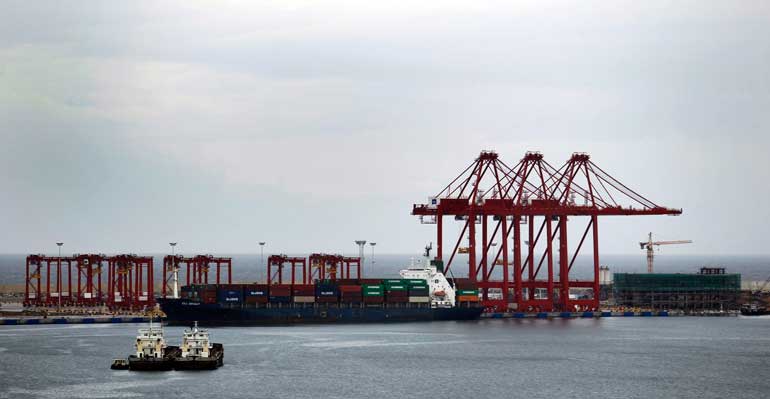Saturday Jan 11, 2025
Saturday Jan 11, 2025
Monday, 4 January 2016 00:09 - - {{hitsCtrl.values.hits}}

A ship at SLPA owned JCT

The Colombo International Container Terminal
By a Rtd. SLPA Chief Engineer
We are not only baffled but perplexed and amused to read news articles where the Minister of Ports and Shipping was taking credit for the Port of Colombo handling 5 million Teus during the year 2015. Facts dished out at these events remind us of the definition given to statistics by a former British Prime Minister, i.e., ‘There are three types of lies – lies, damn lies and statistics’. In the interest of the Ports sector, the truth, nothing but the truth has been unveiled below.
The Port of Colombo comprises of three container terminals and they are, Sri Lanka Ports Authority (SLPA), managed JCT/UCT, South Asia Gateway Terminals (SAGT) and Colombo International Container Terminal (CICT). During 2014 the Port of Colombo handled a container throughput of 4.9M teus, which is a growth of 14% as against the volumes handled in 2013.
In 2015 January, in comes the new administration giving hope to good governance, transparency, accountability and above all professionalism. Has these expectations fizzled out or not? Let us look at plain simple numbers which are factual and un-doctored.
During the first 11 months of 2015 the market share of container volumes handled by SLPA managed container terminals has dwindled to 43% (2,059,948 teus). The private sector led terminals handled a volume of 2,682,702 teus.
Besides, during the 11 months (2015) for the first time in the history of SLPA volumes handled by its terminals has declined by 13% from 2,358,497 teus to 2,059,948teus. Above all, domestic container volume which yields revenue which is four times greater than transshipment has declined by 17% (from 590,996teus to 492,611teus). These are figures against the corresponding period in 2014. Whilst SAGT volumes have also declined, its utilisation however, is well above 150% of its design capacity, whereas the capacity utilisation of SLPA stands at approx. 70%.
Container vessels handled at SLPA managed terminals during the first 11 months of 2015 has contracted by 16.4% (from 1770 to 1486 ships). The throughput growth in the Port of Colombo in 2015 has slowed down to 5% as against 14% in 2014.
The clear winner in the Port of Colombo is CICT, witnessing a growth of 131% in 2015 handling 1.5 million teus during the first 11 months of 2015, with its deep draught, state of the art world class facility led by a professional team.
Whilst a lot has been said on the Hambantota Port, the number of ship arrivals during the first 11 months of 2015 as against 2014 has declined by 48%, thus reflecting the absence of creative imagination on the part of SLPA management for sustained growth.
With the delays in procurement of gantry cranes for the East Container Terminal, the facility is expected to idle till about the end of 2017 spelling disaster to SLPA container volumes. The East Container terminal so far has been funded by a $ 80 million loan from the Bank of Ceylon at an interest rate of LIBOR 5.5%. Are these what the Ports sector expected from the new administration which espoused the cause of professionalism?
Adding to SLPA woes, in 2016 additional loan re-payment will be a staggering Rs. 7.5 billion and from 2018, it will increase up to Rs. 18 billion. These are on account of SLPA borrowing from Exim Bank of China at fixed rates of interest, details of which are $ 307 million at 6.30%, $ 65 million at 6.5%, $ 600 million at 2%. Though the Authority claimed that it has made a revenue of Rs. 25 billion in 2015, it is as against a revenue of Rs. 36 billion achieved in 2014.
The question that is being posed in the Ports sector is as to whether the current administration has the capacity and the know how to prevent the erosion of SLPA which was one time ranked as the most profitable state sector organisation. Whether it’s ‘elle or pandu’ to win, what is required is a good team and as the saying goes ‘One swallow does not make a summer’. Nepotism, loyalty and friends cannot win matches, in particular, when we are up against global giants vying for the footloose transshipment traffic. The need of the hour is to have an administration that knows the difference between ULCCs and VLCCs. Ports sector is an industry where you cannot fool some people even sometimes.
Thus it is evident that the subject of Ports is beyond the comprehension of the current administration and we hope that the Prime Minister will step in to uproot the rot that has set in.